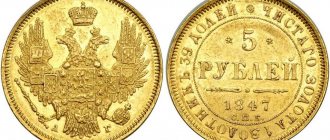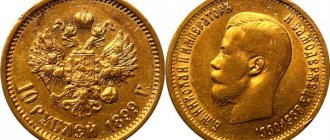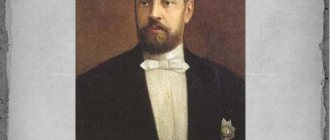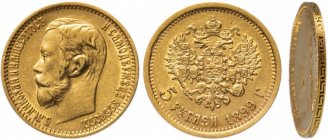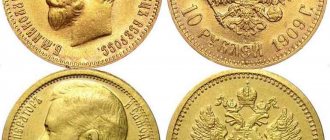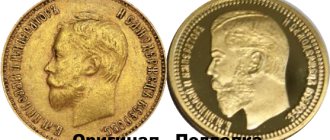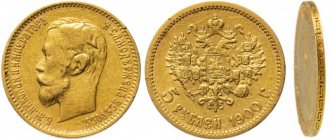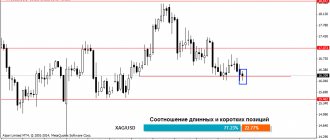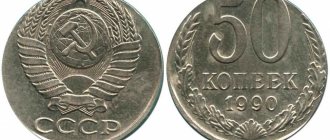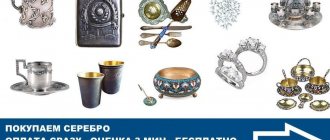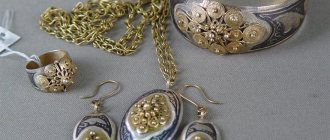Quick links with prices: 5 rubles | 7 rubles 50 kopecks | 10 rubles | 15 rubles | 10 stamps | 20 marks | Semi-Imperial | Imperial
If you want to sell or find out the cost of gold coins of Nicholas 2 , then our store will offer favorable conditions. We provide professional assessment (free) and purchase.
Nicholas 2 ascended the throne in 1894 at the age of 26 after the death of Alexander 3 from kidney disease. The “legacy” of the counter-reformist emperor was not easy. The first half of the 20th century saw action during the Russo-Japanese War, the first revolution, and later the First World War.
Sell 7 rub. 50 kopecks (1897)
7 1/2 rub.
How much can you sell 7.5 gold rubles for?
| Year Coins | Purchase price From | Purchase price Before |
| 1897 | 33 000 | 49 000 |
Price tag date 2021-10-15 Purchase price is indicated in rubles
The appearance of a product with an unusual denomination was associated with monetary and economic reforms. For 1 year - 1897 - minting was carried out under the leadership of Apollo Grashof. The circulation was just over 5,000,000 pieces. Experts who professionally evaluate coins indicate that these items resemble the five-ruble coins of Alexander 2.
Characteristics:
- denomination – 7 rubles. 50 kopecks,
- weight – 6.45 grams (5.81 – pure gold),
- circulation - just over 5,000,000,
- diameter - 21.3 mm.
The items are considered rare because they were not minted during Soviet times. Be careful: Nikolaev coins from rare minting years were often counterfeited. find out how much Nicholas 2 gold is worth after a professional appraisal. Our specialists will conduct an assessment and then offer terms of purchase.
Moscow center, 2 minutes from the metro
+7(800)333-14-77
Instant cash or non-cash payment
Where to sell?
The walls of houses in big cities are plastered with messages: “I will buy coins and antiques.” Contextual advertising does the same thing on the Internet. Numerous antique stores are ready to buy a rare coin from a private seller at any time.
There is a temptation to turn to them. But you need to clearly understand that these numerous offices do not provide the full cost.
And here the Internet comes to the aid of the seller. Domestic and foreign numismatic portals regularly hold auctions.
Approximate calculations of the cost of selling a chervonets through an auction are as follows. From 20 to 40% is added to the cost of the metal.
Is it profitable to sell 10 rubles? (1898-1911)?
Sale 10 rub.
Price of gold ten rubles
| Year Coins | Purchase price From | Purchase price Before |
| 1898 | 30 000 | 39 000 |
| 1899 | 30 000 | 39 000 |
| 1900 | 31 000 | 40 000 |
| 1901 | 31 000 | 40 000 |
| 1902 | 31 000 | 40 000 |
| 1903 | 31 000 | 40 000 |
| 1904 | 35 000 | 55 000 |
| 1906 | rarity | |
| 1909 | 37 000 | 65 000 |
| 1910 | 75 000 | 155 000 |
| 1911 | 31 000 | 39 000 |
Price list date 2021-10-15 The purchase price is indicated in rubles.
The table shows approximately what the cost of ten rubles is. It will be possible to say more specifically after an assessment by our specialist (for this we invite you to a store in Moscow). The cost is due to the fairly large number of products. For example, the circulation in 1900 was 5,372,000. In total, more than 60,000,000 pieces were issued during minting. But 10 rubles. 1910 is considered expensive. If you are interested in how much the 1898 coin costs, come to our store in Moscow.
Coin characteristics:
- diameter – 22.5 mm,
- weight – 8.6 grams (7.74 of which are pure gold).
Compared to the “imperial”, the ten-ruble coins have “lost weight”. This is due to the difficult economic and political situation.
You get up to 80% of the real market price
+7(800)333-14-77
The office is under guard. Petrovka 38 nearby
The rarest and most expensive gold ten-ruble notes from the period of Tsarist Russia
The older the banknote, the fewer copies have survived to this day, especially in good condition. The price of such chervonets is significantly higher than the average. Let me give you a few examples:
- Tsar's chervonets of Peter I, 1712, state of preservation of the three-hundred-year-old gold coin - XF, price - 9 million rubles.
- 10 rubles 1757, Empress Elizaveta Petrovna, portrait by Dacier, safety XF, price - 12,746,457 Russian rubles.
- Emperor Alexander III, imperial 1887, sale price – 4,165,195, Proof preservation.
- The famous Nikolaev 10 rubles, produced in 1906, price – 5,803,120 rubles.
Review 15 rub. last emperor?
Fig 1. Sell Semi-Imperial of Nicholas II
Sell 15 rub. in Moscow
| Year Coins | Purchase price From | Purchase price Before |
| 1897 | 42 000 | 65 000 |
Price tag date 2021-10-15 The purchase price is indicated in rubles.
It is another “atypical” coin that appeared in connection with the monetary reform. In 1897, more than 12 million pieces were minted, in 1899 - almost 2 times more (27 million). But in 1906, only 10 pieces were produced.
Characteristics:
- coinage – “AG” (Apollo Grashof),
- diameter – 24.6 mm,
- weight – 12.9 grams (11.61 – pure gold).
Depending on the obverse stamp, there are 2 varieties: under the neck trim OSS or SS. If you need to sell gold 15 rubles. , contact our store in Moscow. It is known that there were trial denominations of 15, 10 and 5 rubles. There are also so-called “Rus”, which never came into circulation.
Free call within Russia for consultation
+7(800)333-14-77
We buy expensive investment coins
The most expensive ten-ruble notes
People who do not understand numismatics often mistake other gold coins of the same denomination, minted in the same period, for the Nikolaev gold chervonets. They can actually cost hundreds of thousands of dollars apiece. But first things first:
- 10 Rusov. In the first years of the reign of the last Sovereign, Finance Minister Witte tried to radically change the name of the Russian currency. By analogy with the French francs, they chose the name “Rus”. However, this word is not on the coin; instead, there is the inscription “2/3 IMPERIAL” on the reverse. The edge is smooth. On the obverse is a portrait of Nicholas. Five sets were made per sample, but then this idea was abandoned. The cost of the kit averages 400 thousand dollars. But only two can come to market, having gone into personal collections. The other three are in museums. In the Russian Historical Museum, the Hermitage and the American Smithsonian Museum.
- 10 rubles 1906 The cost of a gold chervonets of 1906 is 100–200 thousand dollars. The reason is simple - only 10 of them were cast on the occasion of the anniversary of Nicholas's coronation. The richest collectors from all over the world compete at leading auctions for the right to own these coins, driving up prices to incredible heights.
- Imperials. Beginning numismatists often confuse them with ordinary Nikolaev chervonets, although these are completely different monetary units. You can distinguish it by the inscription “IMPERIAL” on the reverse, above the coat of arms. They were minted for 3 years in a row, from 1895 to 1897, with a total circulation of 375 pieces. Imperials were minted according to the “Alexander foot”; they weigh 12.9 grams. The cost of one copy ranges from 30 to 60 thousand rubles.
Cost 10 marks for Finland
Fig 1. Photo of 10 stamps
How much can you sell 10 stamps for in Moscow?
| Year Coins | Purchase price From | Purchase price Before |
| 1904 | 45 000 | 120 000 |
| 1905 | 115 000 | 225 000 |
| 1913 | 18 500 | 28 000 |
Price list date 2021-10-15 The purchase price is indicated in rubles.
10 stamps for Finland are of interest to numismatists. If you want to sell gold 10 marks, please contact the store in Moscow. Under Nicholas II, coins were minted only in 1904 and 1905. The copies are considered rare: in 1904, only a little more than 100 thousand appeared, and in 1905 - almost 43 thousand pieces. We also buy such items in our store. The 10 stamps for Finland have the following features:
- 900 gold standard,
- 3.23 grams of weight,
- 19.1 mm in diameter.
How to profitably invest in chervonets?
Like any antique, coins from past centuries only increase in value over time. The dynamics of the exchange rate allows us to confidently say that it is possible to sell the gold coins of Nicholas 2 for much more than the price for which they were purchased.
Unlike world gold prices, which are subject to significant fluctuations, prices for Nikolaev chervonets are governed by other patterns.
At first glance, buying and selling Nikolaev chervonets, making money on it, is simple. This is partly true, but be prepared for what will be required of you:
- a large amount for the initial purchase of coins;
- good knowledge of numismatics and history of that era, as well as the ability to understand antiques.
It's not as scary as it seems at first. It is enough to read several books on these topics and consolidate what you read by communicating on specialized forums.
The authenticity of the Nikolaev chervonets must be confirmed by a special certificate. Feel free to request it from the seller. Following a simple rule will also help you avoid deception: buy Nikolaev money only from sellers with a good reputation. To do this, it is useful to register on numismatic forums. There are not many serious sellers; you will find information about possible problematic transactions there.
Sell 20 stamps for Finland
20 Finnish marks
At what price can you sell 20 stamps?
| Year Coins | Purchase price From | Purchase price Before |
| 1903 | 25 000 | 35 000 |
| 1904 | 25 000 | 35 000 |
| 1910 | ||
| 1911 | 25 000 | 35 000 |
| 1912 | rarity | |
| 1913 | 25 000 | 35 000 |
Price list date 2021-10-15 Purchase price is indicated in rubles.
20 stamps were minted in 1903 and 1904. Circulations are 112,000 and slightly more than 188,000, respectively. Expensive items from 1904 and 1905. Place of minting: Helsingfors Mint. 20 stamps are made of the same material, but their weight is almost 2 times greater (6.45 grams), and their diameter is 21.3 mm.
Is it worth investing in gold coins?
Investments in rare banknotes are certainly reliable. You invest in both gold and antiques. Such a gold coin can be sold at least at the current price of the precious metal. But everyone decides the question of benefit for themselves, since this method has its own nuances.
Advantages and disadvantages
Pros:
- Low risk of capital loss.
- The price of rare chervonets from Tsarist Russia is constantly growing.
- In itself, the passion for rarities is a prestigious hobby.
There are also disadvantages. I include among them:
- Low liquidity. Selling at a good price quickly will most likely not work.
- Storage costs (secured premises, safe deposit box).
- Long-term investment. To get a tangible income, you either need to wait 20-50 years, or get incredible luck in the person of a fabulously generous client.
- High entry price when it comes to rare specimens.
Nikolaev chervonets
The reign of the last monarch of the Russian Empire, Nicholas II, presented domestic numismatists with a wide variety of coins, among which gold specimens called chervonets are especially notable. This term is considered obsolete, but in colloquial speech it is often used to refer to ten-ruble bills. Initially, this word was used as a definition of gold coins, since in Rus' copper was added to the ligature for the production of such copies; it gave the noble metal a red tint, which is where the name red gold, that is, red, came from. Nikolaev chervonets were minted in multi-million circulations with many varieties of portrait types on the obverse. Currently, some of this money is used as investment material, while collections are collected according to absolutely different criteria, including the so-called “Soviet” and “tsarist” coinage. Let's consider this topic in more detail.
Witte's monetary reform
In the winter of 1895, Sergei Yulievich Witte presented a report to Nicholas II on the need to introduce a gold standard to strengthen the national currency, which would soon contribute to the economic recovery of the state. In domestic circulation, full-fledged gold and silver coins did not exist since 1885; the main currency for the population was banknotes, which, although backed by precious metals, were not exchanged by state and private banks for a hard equivalent. Because of this, such means of payment did not inspire confidence among citizens. Gold chervonets, previously used only for interstate payments, would strengthen the authority of the ruble.
Banknote 25 rubles sample 1892
Thanks to long and meticulous work, the first trial batches of imperials and russ appeared at the St. Petersburg Mint. A feature of these options was a double denomination, but they were not approved. The Nicholas Imperial was produced for three years in a row in batches of 125 pieces, which is why its cost is currently over a million rubles. The Rus produced only a few sets, so now they can only be seen in state museums.
Obverse and reverse of double denomination gold coins
As a result of transformations in 1897, coins appeared in denominations of 5 rubles, 7 rubles 50 kopecks and 15 rubles. The 900 standard and the metal content in them corresponded to the coins from the reign of Alexander the Third, but their denomination was changed by one and a half times. It turned out that the old 10 rubles were equal to 15 new ones. The following year, a 10-ruble coin also came into circulation.
Reverse of gold coins from the reign of Alexander III and Nicholas II
The reform carried out significantly improved the economic climate within the state and made it possible to increase Russia's potential in the international arena. This allowed domestic businesses to attract Western investment.
5 rubles
The smallest and at the same time the most widespread Nikolaev gold coin turned out to be 5 rubles. Their minting began in 1897 and continued until 1911. During this time, the total circulation was approximately 130 million copies. Despite this, some specimens still remain relatively rare and cost several hundred thousand rubles. According to the technical characteristics, the weight of each was 4.3 grams (pure gold - 3.87 grams), diameter - 18.5 mm, and thickness - 1.2 mm. On the obverse along the edge there is an inscription: “B.M. NICHOLAS II EMPEROR AND AUTOCRET OF ALL RUSSIA,” and in the center they presented the profile of the emperor. The reverse depicts the Small State Emblem of the Russian Empire, model 1883, below it the denomination and year of issue are indicated. A pattern was depicted on the edge, interrupted on one side by two letters denoting the initials of the mintzmeister, and on the other by a rhombus.
5 rubles 1898
There are six main types of portraits of Nicholas II. The most valuable red nickels are considered to be those issued after 1904, since their circulations relative to previous issues were small (1910 - 200,018 copies, 1911 - 100,011 copies) or were minted in single copies (1906 - 10 coins, 1907 – 109 coins, the number of 5 rubles of 1909 has not been established).
7 rubles 50 kopecks and 15 rubles
The design of the obverse and reverse of 7 rubles 50 kopecks and 15 rubles coincides with the previously described denomination, however, instead of a pattern, the inscription on their edge was written: “Pure gold 1 spool 34.68 shares A●G” and “Pure gold 2 spools 69.36 shares A ●G.” The indicated letters “AG” are the initials of Apollo Ludwigovich Grashof, who served as manager of gold and silver coin redistribution at the St. Petersburg Mint from 1883 to 1899.
7 rubles 50 kopecks and 15 rubles 1897
These coins can only be found with a single date – “1897”. According to V.V. Uzdenikov this year, 11,900,033 pieces of 15-ruble notes and 16,829,000 coins of 7 rubles 50 kopecks were minted, after which the minting was stopped. According to the technical characteristics, the imperial (15 rubles) weighs 12.9 grams (of which 11.61 grams are pure gold), the diameter is 24.6 mm, and the thickness is 1.9 mm. The weight of the semi-imperial is 6.45 grams (of which 5.8 grams are pure gold) with a diameter of 21.3 mm and a thickness of 1.2 mm. Since they were not produced for long, at the very beginning of the reign of Nicholas II, excellently preserved specimens are very rare and valuable.
10 rubles
The last coin is often called the Nicholas Chervonets. The gold ten-ruble note is the most attractive collectible and investment material from the coins of the imperial period. She earned this position thanks to her large circulation. The pure gold content in it is approximately ¼ ounce, which is convenient for calculations. It is also famous for its considerable variety of obverses, combined with various initials of mintzmeisters, and several varieties of reverses.
10 rubles 1899
The design of the chervonets does not stand out, the inscription on its edge says: “Pure gold 1 spool 78.24 shares,” followed by the initials of the master of the mint. The weight of the coin is 8.6 grams (of which 7.74 grams are pure gold), diameter – 22.5 mm, thickness – 1.7 mm. However, it is on it, and not on the more widespread 5 rubles, that the largest variety of portraits is distinguished. When combined with other sides of the coin, the full collection of varieties amounts to several hundred pieces. And the most widespread year of minting of chervonets - 1899, provides the largest selection, for example, a “special” type of portrait of Nicholas II, found exclusively with a date of 1899 and the initials “FZ” (Felix Zaleman).
Soviet coinage
The most controversial topic regarding gold chervonets remains the Soviet coinage. The very issue of tsar-style coins at the Leningrad courtyard in the period from 1923 to 1926 causes quite logical bewilderment. However, thanks to the archival work of a number of historians and numismatists, it was possible to understand this complex issue and establish this fact. However, the quantity of such money, their dates and denominations are not reliably known.
A young state with a weakened economy due to ongoing international conflicts and civil war needed a reliable currency. The production of large silver coins according to pre-revolutionary standards, but with a new design that appeared in 1921, did not ensure the circulation of the necessary money supply. Because of this, they began to accept the royal gold coin for payments. It is also worth noting that they refused to sell imported goods for Soviet Russia for Soviet money, and the reserves of the old red coin were running out by that time; all these circumstances forced the production of such copies to begin in 1923. In parallel with this, work was organized on the design of a new currency and in the same year a coin with a denomination of one chervonets was minted, later called the “sower” among numismatists; its technical characteristics and gold content corresponded to the imperial 10 rubles.
Chervonets 1923
Experienced numismatists distinguish coins of the “Soviet” mintage from the “tsarist” ones, highlighting in them the mistakes made by the craftsmen of the Leningrad court when issuing chervonets. For example, the “late” type of portrait, characteristic of coins since 1900, suddenly appeared on ten-ruble copies dated 1898 and 1899, and on 5 rubles of 1897 and 1898 two types of “big head” portraits, which were made in later times, are widely found. years.
Gold coins of Nicholas II, presumably from the Soviet period of minting
The initials of the mintzmeisters were also changed. For example, the letter “G” with an elongated ending resembles a gallows, and the letter “P” is depicted in the form of a flag.
Edge inscriptions of gold coins with various types of writing of the initials of mintzmeisters
However, such signs are indirect, and indeed frequent experiments in production could have caused the appearance of uncharacteristic specimens even under the monarchy. Therefore, in collection catalogs you can often find the postscript “probably Soviet coinage.” But there is an exception. The 1911 Nicholas Chervonets, according to the reporting documents of the St. Petersburg Mint, was produced in a modest edition of 50,011 pieces. This circumstance should have made the specimens very rare, but they are common. Most likely, the instrument from the last year of minting was preserved in good condition, which made it possible to launch the production of many thousands of copies dating back to 1911. It is extremely difficult to identify “Tsarist” and “Soviet” coinage, but there are indirect signs. It is assumed that the alloy for the Nikolaev chervonets in the 20s was prepared in a different ratio of metals. The gold content of the supposed later coins is slightly higher, the copper content is lower, and silver is either absent or present in percentages. However, the vast majority of coins with the date 1911 are Soviet.
Work on studying the archives and the chervonets themselves continues, so new interesting facts may soon appear.
